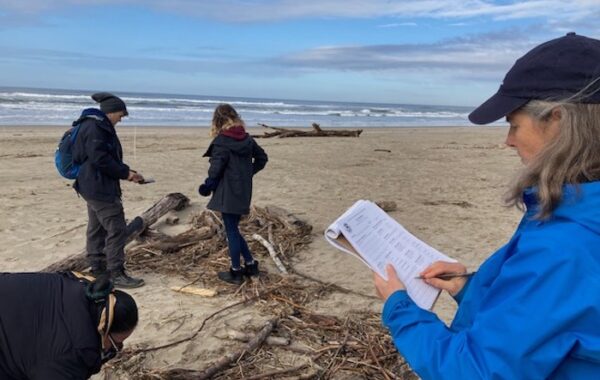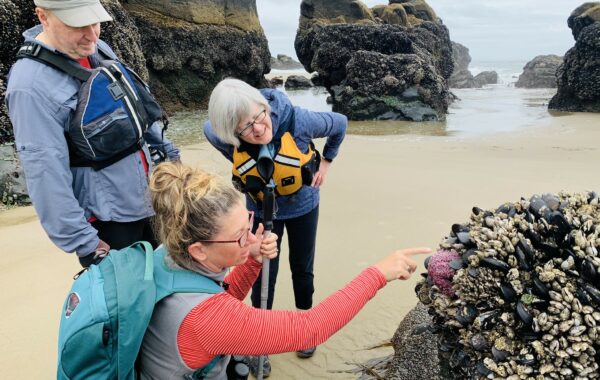everything you need to know on the beach
Getting Started
Congratulations on taking the first steps towards being a coastal steward! We are so grateful you’ve joined our CoastWatch community.
Explore this page for resources on conducting and uploading your CoastWatch Mile Reports, detailed descriptions of what to look for, and essential contact information. If you have any questions, always feel free to reach out. CoastWatch orientations are held online bi-monthly and throughout the year on the beach in each Oregon coastal county (Clatsop, Tillamook, Lincoln, Lane, Douglas, Coos, and Curry); you are not required to attend an orientation before submitting your first CoastWatch report.
Looking to connect with other CoastWatchers? Join our Oregon Shores CoastWatchers Facebook group! Be sure to answer the questions after you request to join- this helps us keep this group to CoastWatch Volunteers only.
If you like, you can download a PDF of the form to take with you.

Filing Your Report
To complete your first CoastWatch report, you must submit a CoastWatch application form and receive a welcome email, including the password to access the “Submit a Mile Report” page.
There are two easy ways to access the online form: visit the CoastWatch page and click “Submit a Mile Report” on the left-side menu, or hover over “Get Involved” on the main menu and click “Submit a Mile Report.” Please fill out each section as thoroughly as possible and leave it blank if there is no information to fill in. Use the “previous” and “next” buttons at the bottom of the form to move between pages. The summary may be as brief as you like but should include the most notable aspects of your beach experience.
The maximum photo file size is 8 MB. Please do not send more than 12 photos per report. Accepted file formats: .jpg, .jpeg, .png.
If you need to edit your report, including adding photos, please contact Jesse.

More Questions? Check out our FAQs
First Steps
Getting acquainted with your CoastWatch mile and tips for being an effective CoastWatch volunteer.
-
Locating your CoastWatch Mile
Check out the CoastWatch Miles and Reports page. The link for Google Maps leads to the center of that particular stretch of mile. Once you have this information, you can use landmarks to determine your approximate boundaries. Look for permanent reference marks like buildings, roads, trees, or bluffs and rocks to help you. Visit this page to see the coordinates of all the mile boundaries. If you have any questions, email Jesse.
-
Accessing Your Mile
Please report on the condition of the public access point or points you used to enter and exit the beach. Has it been improved, blocked, or recently eroded? Are there new access points?
-
What to Bring
Aside from your phone or camera for taking pictures, bringing a bag or bucket and gloves to collect marine debris is always a good idea. The majority of CoastWatchers report that they’ve removed debris from their mile. Other good tools are binoculars and a tally counter. You can download a PDF of the report form to take with you or complete the report from your phone or computer.
-
What to Photograph
Try and capture a north and a south view of the beach from a location you can reach each time to show changes in the dunes, cliffs, access points, buildings, and infrastructure at the back of the beach. Focus on beached marine mammals, notable beached birds, high concentrations of dead or live wildlife, signs of high tide activity (driftwood movement), marine debris you removed or could not remove, and the wrack line.
-
Safety first! Know the Tides
Upload a tide app to your phone, check this website beforehand, or carry a hard copy version. If your beach is narrow and not accessible or dangerous at high tide, you can observe from above. Capturing your beach with a photo at a regular high tide makes for a good comparison photo for the Oregon King Tides Project.
-
Does My Mile Have a Special Designation?
Additional rules exist in designated areas like Marine Education Areas, Marine Research Areas, Marine Protected Areas, and Marine Reserves. Find your CoastWatch Mile on our map to see if it lies in a designated area. Learn about designations here.
What to Observe
Look for changes to the landscape, both human caused and natural. Examine the wrack line. Scan for wildlife, both dead and alive. Take note of activity on the shore.
-
Human Activities
How many people, dogs, and vehicles were on your mile, and what were they doing? Managers of the ocean shores and state parks use this information
-
Shoreline Wildlife
What was in the wrack line? What notable wildlife (alive and dead) was on the shoreline?
Learn more about what you can do if you find:
-
What are the big yellow signs?
Neon-green signs numbered signs are an effort to help visitors identify their location in an emergency. The signs stretch from Fort Stevens State Park in the north to Crissey Field State Park at the California state line. These numbers are relayed to 911 dispatchers, who can tie the number to a GPS location and the closest beach access point. Call 911 and relay the number on the sign if you witness a true emergency.
What should I do if I see...
-
A Stranded or Injured Marine Mammal
The easiest way to report is to call the NOAA West Coast Stranding Hotline, which covers the entire West Coast area and will send your report to the appropriate stranding contact. Their number is: 1-866-767-6114
Be sure to complete a report on our website, too- thank you for helping us learn more about marine mammals on our coast!
-
A Different Type of Animal In Trouble
Thanks for looking out! Here are some helpful numbers and contact:
- Sea turtles and seabirds – Oregon Coast Aquarium 541-867-3474
- Banded birds – US Fish and Wildlife 541-867-4550
- Raptors, perching birds, or other wildlife – Chintimini Wildlife Center in Corvallis 541-745-5324
- Land mammals or other wildlife – Oregon Department of Fish and Wildlife 541-867-4741
- Sharks and rays – Big Fish Lab at Hatfield Marine Science Center
-
People Behaving Badly
Depending on the severity of their behavior, you can call a park ranger in the area (numbers listed below) or the Oregon State Police Tipline 800-452-7888.
-
Beach Trash or Marine Debris
Consider taking marine debris to your home container. If this isn’t possible, deposit it in beach trash cans. If what you have collected is too large to fit into a can, leave the bag beside the trashcan and make sure the trash is secure so it doesn’t re-pollute. If you have a large amount of debris in a bag and leave it near the beach containers and/or you encounter an extra large item (like a tire, furniture or appliances), contact a beach ranger and tell them where you left the debris. This helps beach rangers tremendously and helps keep our beach accesses clean. See county lists below for phone numbers.
-
Fires or Fireworks
If you encounter an unattended fire, contact a beach ranger or extinguish it if it is safe and possible. Portions of the Oregon beach areas are permissible for campfires, and only paper products and untreated natural wood free of attached metal, nails, glass, or plastic objects are allowed. Do not use gasoline, diesel, or petroleum-based products. Wood must be no longer than 24 inches in length. Fires should be attended at all times and extinguished entirely with water. Ensure that any fire set does not cause personal injury or damage to private property or park resources. Some communities have developed local rules.
All fireworks are prohibited in all state parks and on ocean beaches.
What are the Beach Rules and Who do I Contact?
Oregon State Parks and Recreation has jurisdiction over the beaches, but the rules change beach to beach. Federal, state, county and municipal regulations overlap in many places. There are general beach rules around driving, fires, driftwood removal and shellfish harvesting.
Usually, it is best to Oregon State Police for enforcement and corrective action. Oregon State Police Tipline 800-452-7888. For everything else, please contact your beach rangers.
-
General Rules, Safety and Permit
Check out this website to learn general beach rules around driving, fires, driftwood removal, shellfish harvesting, and more.
Additional rules exist in designated areas like Marine Education Areas, Marine Research Areas, Marine Protected Areas, and Marine Reserves. Find your CoastWatch Mile on our map to see if it lies in a designated area. Learn about designations here.
-
Clatsop County
- District Manager, North Coast District Office, Hammond, 503-861-3170 x23
- Manager, Fort Stevens Management Unit Office, Hammond, 503-861, 3170 x27
- Park Ranger Supervisor, Hammond, 503-861, 3170 x22
- Ecola State Park, Park Ranger, 503-812-0650
-
Tillamook County
- Oswald West, Office, 503-812-0650
- Nehalem Bay Park Manager, Nehalem, 971-601-0595 x23
- Nehalem Bay Park Ranger Supervisor 971-601-0595 x22
- Nehalem Bay, Beach Ranger, 971-701-3635 x29
- Cape Lookout Park Manager 503-842-3182 x222
- Cape Lookout Ranger Supervisor, 503-842-3182 x223
- Cape Lookout, Park Ranger, 503-842-3182 x224
- Cape Lookout, Park Ranger, 503-842-4981
- Cape Kiwanda State Natural Area, Park Ranger, 503-440-8924
-
Lincoln County
- Central Coast District Office Manager, Depoe Bay, 541-270-4232
- Central Coast Park Ranger, 541-270-7995
- Devil’s Lake Management Unit Manager, 541-994-7341
- Beverly Beach Park Manager, 541-265-4560
- Depoe Bay Whale Watch Center, 541-765-3304
- Ellmaker State Wayside 503-877-0028
- Otter Crest State Scenic Viewpoint (Cape Foulweather) 541-765-2270
- Yaquina Bay Lighthouse 541-265-5679
- South Beach Management Unit Manager 541-867-7451
- Brian Booth State Park Visitor Center 541-563-6413
- Coastal Region Office, Waldport, 541-563-8500
-
Lane County
- Honeyman Management Unit Park Manager 541-997-3851
- Honeyman Park Ranger Supervisor 541-999-5711
- Carl G Washburne Management Unit Manager 541-547-3416
- Carl G Washburne Park Specialist 541-997-3851
- Carl G Washburne Park Ranger 541-997-3851 x229
- Heceta Head Lighthouse Office 541-547-3437
-
Douglas County
- Umpqua Lighthouse Office 541-271-4118
- Umpqua Ranger Winchester Bay 541-999-6691
-
Curry County
- Gold Beach Police Department https://www.goldbeachoregon.gov/police
- Harris Beach Management Unit Manager 541-469-0224 x220
- Harris Beach Ranger Supervisor 541-469-0224 x401
- Harris Beach Park Ranger 541-469-0224 x404
